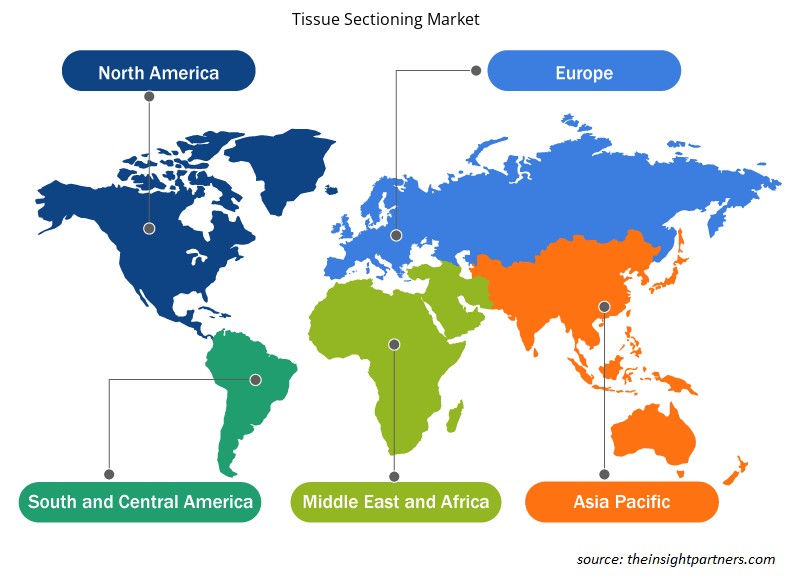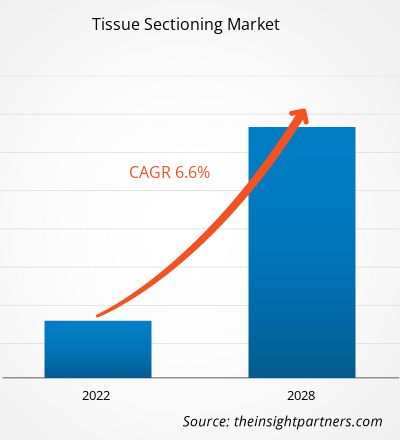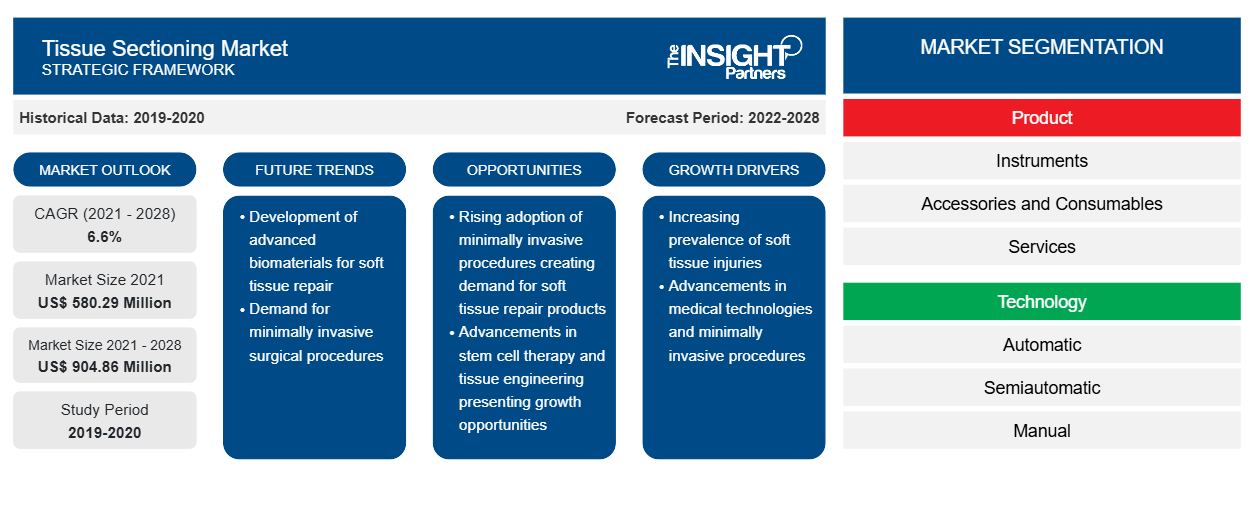Si prevede che il mercato del sezionamento dei tessuti raggiungerà i 904,86 milioni di dollari entro il 2028, rispetto ai 580,29 milioni di dollari del 2021; si prevede una crescita a un CAGR del 6,6% dal 2021 al 2028.CAGR of 6.6% from 2021 to 2028.
Il sezionamento dei tessuti è una procedura che prevede il taglio dei tessuti in sezioni sottili in modo che possano essere posizionate su un vetrino e poi montate al microscopio per lo studio. Viene utilizzata per esaminare il tessuto per rilevare eventuali anomalie o condizioni patologiche. Viene impiegata nei laboratori di istologia, nei laboratori scientifici e in altri contesti. L'elaborazione dei tessuti viene eseguita dopo che il tessuto è stato esaminato tra l'inclusione e la fissazione del tessuto.
Il rapporto offre approfondimenti e analisi approfondite del mercato del sezionamento dei tessuti , sottolineando vari parametri come tendenze di mercato, progressi tecnologici, dinamiche di mercato e analisi del panorama competitivo dei principali attori del mercato in tutto il mondo. Include anche l'impatto della pandemia di COVID-19 sul mercato in tutte le regioni. La pandemia ha sconvolto le condizioni socioeconomiche di vari paesi in tutto il mondo. Attualmente, gli Stati Uniti sono il paese più colpito al mondo a causa dell'epidemia di COVID-19 con il numero più alto di casi confermati e decessi, secondo le recenti statistiche dell'OMS. L'elevato numero di casi positivi al COVID-19 ha avuto un impatto negativo sulle economie globali. C'è stato un calo delle attività commerciali complessive e la crescita di vari settori che operano in tutto il mondo.
Personalizza questo report in base alle tue esigenze
Riceverai la personalizzazione gratuita di qualsiasi report, comprese parti di questo report, o analisi a livello nazionale, pacchetto dati Excel, oltre a usufruire di grandi offerte e sconti per start-up e università
-
Scopri le principali tendenze di mercato in questo rapporto.Questo campione GRATUITO includerà analisi di dati che spaziano dalle tendenze di mercato alle stime e alle previsioni.
Ci sono stati vari fattori, tra cui l'aumento dell'incidenza di pazienti positivi al COVID-19, la crescita della ricerca, l'aumento della produzione di vaccini, lo studio degli esiti dei vaccini somministrati e molti altri fattori. Ad esempio, il College of American Pathologists ha condotto una ricerca per segnalare le caratteristiche demografiche e radiografiche nei polmoni dei pazienti infetti e deceduti con COVID-19 fatale. Tutte le autopsie sono state eseguite presso il College of American Pathologists. Lo studio ha rivelato che i pazienti infetti da COVID-19 non solo hanno danni alveolari diffusi, ma hanno anche comunemente broncopolmonite acuta e polmonite da aspirazione. I casi hanno portato principalmente alla domanda di test diagnostici in paesi come Stati Uniti, Canada e Messico. Pertanto, il mercato del sezionamento dei tessuti in Nord America è positivamente influenzato dal COVID-19.radiographic features in the lungs of patients infected and deceased with fatal COVID-19. All autopsies were performed at the College of American Pathologists. The study revealed that patients infected with COVID-19 not only have diffuse alveolar damage but also commonly have acute bronchopneumonia and aspiration pneumonia. The cases majorly led to the demand for diagnostic tests in the countries like the US, Canada, and Mexico. Thus, the tissue sectioning market in North America is positively impacted by COVID-19.
In base alla regione, il mercato del sezionamento dei tessuti è segmentato in Nord America, Europa, Asia Pacifico, Medio Oriente e Africa, America meridionale e centrale.
Approfondimenti di mercato
Crescente adozione della medicina personalizzata per guidare il mercato del sezionamento dei tessuti
La medicina personalizzata o di precisione è diventata il segno distintivo del trattamento per una serie di gravi malattie e si è estesa ad altri campi con la sua applicazione. È un approccio in continua evoluzione per personalizzare le terapie in base all'accumulo genetico dei pazienti. Questi progressi tecnologici hanno portato ad approcci di sezionamento dei tessuti che ottengono risultati migliori con le risorse disponibili in meno tempo. Per la prevenzione e il trattamento efficiente di una malattia, le medicine personalizzate sono strumenti obbligatori, specialmente nei casi di oncologia e nefrologia. I casi di cancro in rapido aumento stanno contribuendo indirettamente alla crescita del mercato del sezionamento dei tessuti.nephrology cases. The rapidly increasing cancer cases are indirectly contributing to the growth of the tissue sectioning market.
Ad esempio, secondo l'OMS, il cancro è la principale causa di morte in tutto il mondo, con quasi 10 milioni di decessi nel 2020. Il cancro ai polmoni, al fegato, al sangue e al seno sono i tipi di cancro più comuni. Tra il 30% e il 50% dei tumori può essere attualmente prevenuto attraverso una diagnosi precoce del cancro e un trattamento e una cura appropriati dei pazienti. Molti tumori hanno un'alta probabilità di essere curati se diagnosticati precocemente e trattati in modo appropriato, ha affermato l'OMS. Il crescente utilizzo della medicina personalizzata ha spinto un aumento della domanda di utilizzo di tessuti umani per promuovere test innovativi.
Approfondimenti basati sui prodotti
In base al prodotto, il mercato del sezionamento dei tessuti è categorizzato in strumenti, accessori e materiali di consumo e servizi. Il segmento degli strumenti ha rappresentato la quota maggiore del mercato. Il segmento degli strumenti è suddiviso in microtomo rotante, microtomo scorrevole, ultramicrotomo, criostato e altri. subsegmented into rotary microtome, sliding microtome, ultramicrotome, cryostat, and others.
Approfondimenti basati sulla tecnologia
In base alla tecnologia, il mercato del sezionamento dei tessuti è segmentato in automatico, semiautomatico e manuale. Il segmento della tecnologia automatica deterrebbe la quota maggiore del mercato nel 2021 e si stima che lo stesso segmento registrerà il CAGR più alto del 7,0% nel mercato durante il periodo di previsione.CAGR of 7.0% in the market during the forecast period.
Approfondimenti basati sulle applicazioni
In base all'applicazione, il mercato del sezionamento dei tessuti è segmentato in diagnosi e ricerca. Nel 2021, il segmento della diagnosi deterrà la quota maggiore del mercato. Inoltre, si prevede che anche il segmento della ricerca assisterà a una crescita al CAGR più rapido del 7,2% dal 2021 al 2028.CAGR of 7.2% from 2021 to 2028.
Informazioni basate sull'utente finale
In base all'utente finale, il mercato del sezionamento dei tessuti è segmentato in ospedali, istituti di ricerca e altri. Il segmento degli istituti di ricerca deterrà la quota maggiore del mercato nel 2021 e si prevede che lo stesso segmento registrerà il CAGR più elevato del 10,9% del mercato durante il periodo di previsione.CAGR of 10.9% of the market during the forecast period.
Gli operatori del mercato del sezionamento dei tessuti adottano strategie organiche, come il lancio e l'espansione dei prodotti, per espandere la propria presenza e il portafoglio prodotti in tutto il mondo e soddisfare la crescente domanda.
Approfondimenti regionali sul mercato del sezionamento dei tessuti
Le tendenze regionali e i fattori che influenzano il mercato del sezionamento dei tessuti durante il periodo di previsione sono stati ampiamente spiegati dagli analisti di Insight Partners. Questa sezione discute anche i segmenti e la geografia del mercato del sezionamento dei tessuti in Nord America, Europa, Asia Pacifico, Medio Oriente e Africa e America meridionale e centrale.

- Ottieni i dati specifici regionali per il mercato del sezionamento dei tessuti
Ambito del rapporto di mercato sul sezionamento dei tessuti
| Attributo del report | Dettagli |
|---|---|
| Dimensioni del mercato nel 2021 | 580,29 milioni di dollari USA |
| Dimensioni del mercato entro il 2028 | 904,86 milioni di dollari USA |
| CAGR globale (2021 - 2028) | 6,6% |
| Dati storici | 2019-2020 |
| Periodo di previsione | 2022-2028 |
| Segmenti coperti |
Per Prodotto
|
| Regioni e Paesi coperti |
America del Nord
|
| Leader di mercato e profili aziendali chiave |
|
Densità degli attori del mercato del sezionamento dei tessuti: comprendere il suo impatto sulle dinamiche aziendali
Il mercato del Tissue Sectioning Market sta crescendo rapidamente, spinto dalla crescente domanda degli utenti finali dovuta a fattori quali l'evoluzione delle preferenze dei consumatori, i progressi tecnologici e una maggiore consapevolezza dei benefici del prodotto. Con l'aumento della domanda, le aziende stanno ampliando le loro offerte, innovando per soddisfare le esigenze dei consumatori e capitalizzando sulle tendenze emergenti, il che alimenta ulteriormente la crescita del mercato.
La densità degli operatori di mercato si riferisce alla distribuzione di aziende o società che operano in un particolare mercato o settore. Indica quanti concorrenti (operatori di mercato) sono presenti in un dato spazio di mercato in relazione alle sue dimensioni o al valore di mercato totale.
Le principali aziende che operano nel mercato del sezionamento dei tessuti sono:
- Termo Fisher Scientifico
- Leica Biosystems Nussloch GmbH
- LLS ROWIAK LaserLabSolutions GmbH
- Sakura Finetek Europe BV
- Diapath SpA
Disclaimer : le aziende elencate sopra non sono classificate secondo un ordine particolare.

- Ottieni una panoramica dei principali attori del mercato del sezionamento dei tessuti
Per Prodotto
-
Strumenti
- Microtomo rotativo
- Ultramicrotomo
- Criostato
- Microtomo scorrevole
- Altri
- Accessori e materiali di consumo
- Servizi
Per tecnologia
- Automatico
- Semiautomatico
- Manuale
Per applicazione
- Diagnosi
- Ricerca
Da parte dell'utente finale
- Ospedali
- Cliniche
- Laboratori Diagnostici
- Laboratori di percorso digitale
- Altri
Per Geografia
-
America del Nord
- NOI
- Canada
- Messico
-
Europa
- Francia
- Germania
- Italia
- Regno Unito
- Spagna
-
Asia Pacifico (APAC)
- Cina
- India
- Corea del Sud
- Giappone
- Australia
-
Medio Oriente e Africa (MEA)
- Sudafrica
- Arabia Saudita
- Israele
-
America del Sud e Centro (SCAM)
- Brasile
Profili aziendali
- Termo Fisher Scientifico
- Leica Biosystems Nussloch GmbH
- LLS ROWIAK LaserLabSolutions GmbH
- Sakura Finetek Europe BV
- Diapath SpA
- Laboratori Histo-line
- Medite Medical GmbH
- SLEE medical GmbH
- Abcam S.p.A.
- Amas Scientific Pty Ltd
- Analisi storica (2 anni), anno base, previsione (7 anni) con CAGR
- Analisi PEST e SWOT
- Valore/volume delle dimensioni del mercato - Globale, Regionale, Nazionale
- Industria e panorama competitivo
- Set di dati Excel
Report recenti
Testimonianze
Motivo dell'acquisto
- Processo decisionale informato
- Comprensione delle dinamiche di mercato
- Analisi competitiva
- Analisi dei clienti
- Previsioni di mercato
- Mitigazione del rischio
- Pianificazione strategica
- Giustificazione degli investimenti
- Identificazione dei mercati emergenti
- Miglioramento delle strategie di marketing
- Aumento dell'efficienza operativa
- Allineamento alle tendenze normative























 Ottieni un campione gratuito per - Mercato del sezionamento dei tessuti
Ottieni un campione gratuito per - Mercato del sezionamento dei tessuti